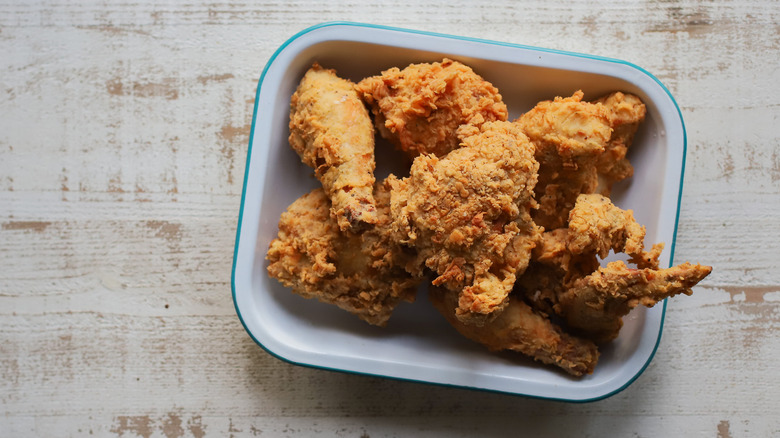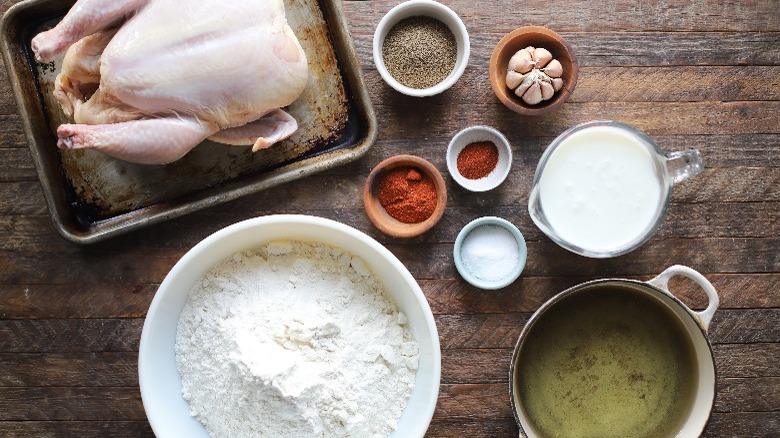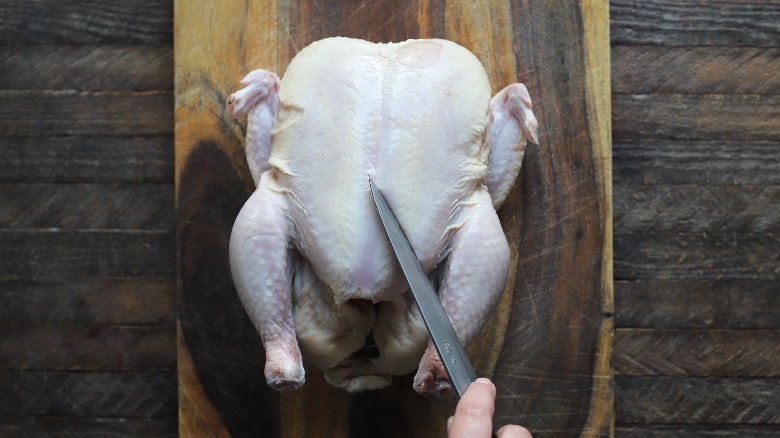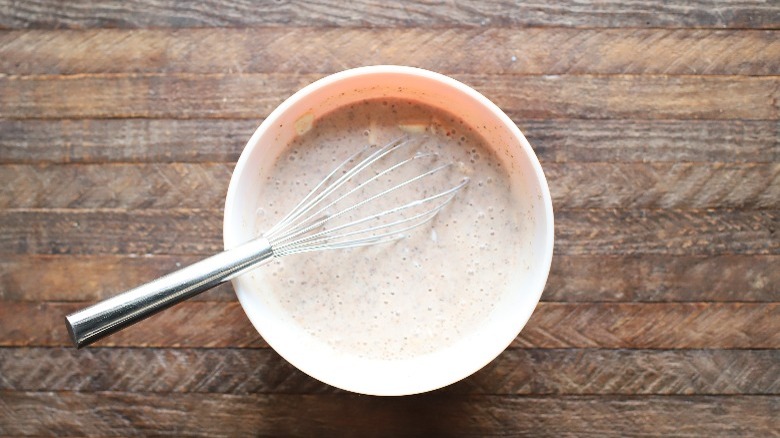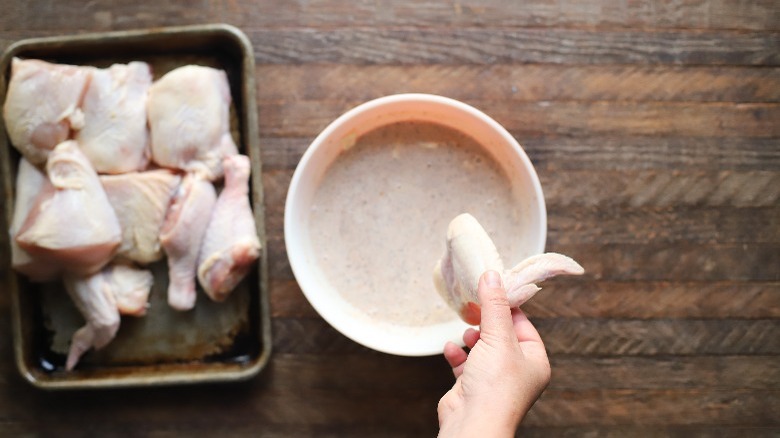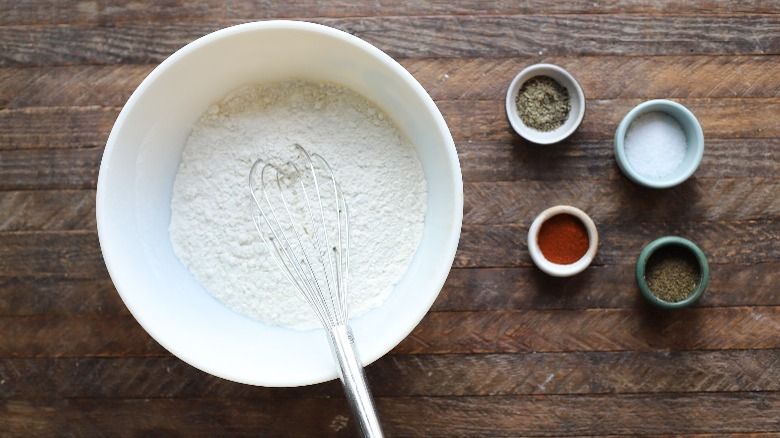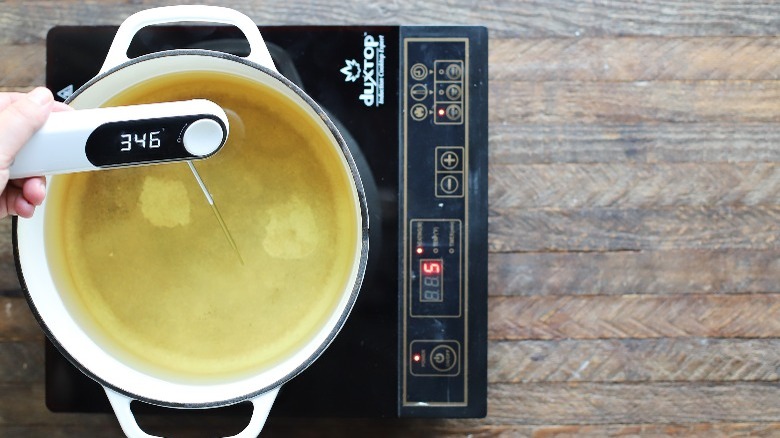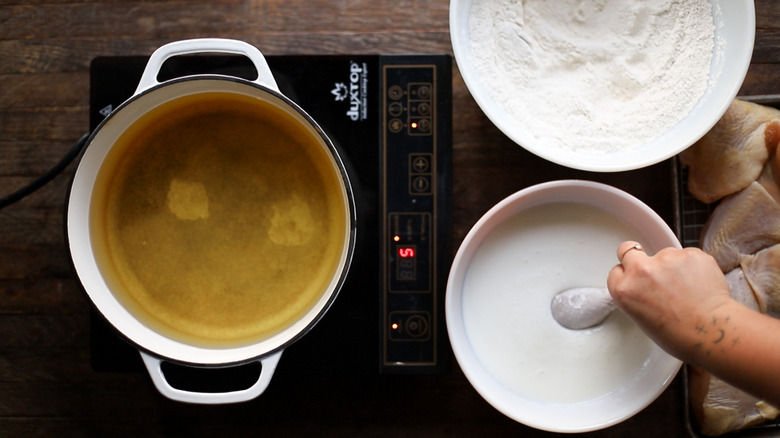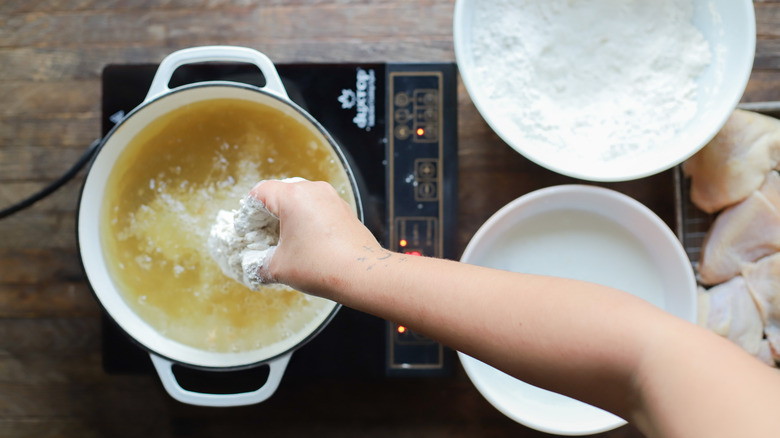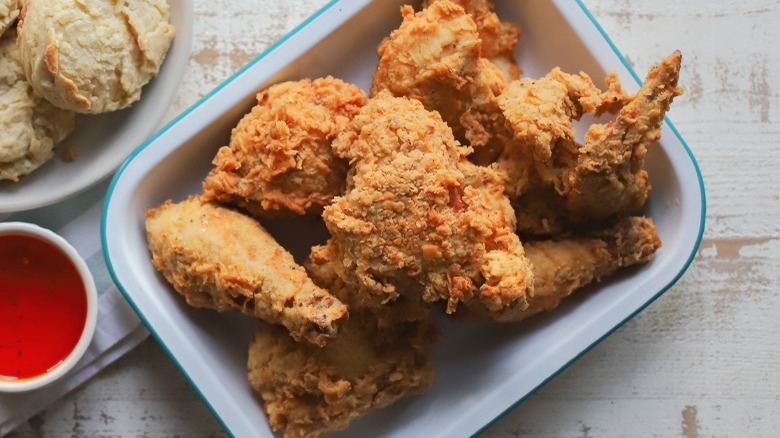Spicy Buttermilk Fried Chicken Recipe
In the pantheon of all-time great foods, fried chicken surely has one of the top spots as one of the world's most beloved dishes. A golden brown, shatteringly crisp crust dotted with seasonings and surrounding juicy, succulent chicken is a tough one to beat. Whether served on a sandwich or straight-up on a plate with some biscuits and mashed potatoes, fried chicken is a crowd-pleaser. The only problem? A complicated breading process and a lengthy marinade time make this somewhat of a challenge for home cooking.
For this fried chicken recipe, recipe developer Taylor Murray created a method for rapidly marinating the chicken so it's ready in hours, not days. The breading process is simple and streamlined, which only leaves a dip in some hot oil standing between you and crispy, hot chicken goodness. Murray says, "This recipes packs a big punch of heat, but if you prefer your chicken a bit more mellow, feel free to cut the amount of cayenne pepper by half, or more."
Gather your fried chicken ingredients
The ingredients for fried chicken are simple and cheap. All you really need for super-crispy fried chicken is a chicken (obviously), flour, buttermilk, and a few spices, plus the oil for frying. While even cheap chicken will taste great once fried, better quality chicken will always have a richer depth of flavor. "Buying a whole chicken (as opposed pieces)," Murray advsises, "offers more control over the size and shape of each cut, plus it is often cheaper and you end up with a carcass that can be repurposed for chicken stock."
Use fresh spices for more flavor, if possible. Celery seed is a rarely used ingredient, but oh-so tasty with fried chicken. The amount of cayenne can be adjusted to suit your spice level, or even omitted completely. Rounding out the spices and seasonings used are salt, sugar, fresh garlic, paprika, and black pepper.
Break down the chicken
The first step in preparing fried chicken is to get your pieces of chicken ready. You can always buy pre-cut pieces of just legs or skin-on breasts to save yourself some time, or ask your butcher to break the chicken down for you. If you want to take a stab at cutting up a whole chicken yourself, we believe it's worth the effort. There are multiple ways to cut a whole chicken, but cutting it into 8 or 10 pieces is ideal for frying. First, make angled cuts between the leg and the breast, carving underneath the hip bone to separate the leg from the body. Find the ribbon of fat between the drumstick and thigh and make a cut there to separate the two pieces. Repeat on the other side and set aside.
To remove the wings, flip the bird upside down and fine the connecting joint. Cut around the joint and pop it out of the socket, then make a clean cut to remove. For fried chicken, it's best to leave the wing whole (so it'll cook in a similar time to other pieces). Lastly, remove the breasts by finding the breast bone that runs down the center and making a cut just to the side of it. Continue cutting, following the rib bones, until the breast comes free of the carcass. Be careful to keep all the skin attached. Some people prefer to cut each breast into two pieces crosswise (the difference between getting 8 or 10 pieces). These smaller pieces can be quicker to fry and easier to eat, but it depends on the total size of the chicken.
Prepare the marinade
Once the chicken is cut, prepare the marinade. Pour the buttermilk into a large bowl and whisk in the salt, white sugar, sliced garlic, celery seed, paprika, and cayenne pepper. The ½ cup salt the recipe calls for in this step may seem like a lot, but trust us: This marinade is more of a brine, and it's an especially concentrated brine at that. This allows you to get a maximum amount of flavor into the chicken in a quick amount of time (unlike some recipes that have you marinate overnight).
Make sure not to leave the chicken in too long! This concentrated brine can make your chicken too salty if it's left in more than 4 hours. If you need to marinade longer for any reason, decrease the salt to 2 tablespoons and the sugar to 2 teaspoons. Once the chicken is in the buttermilk mixture, cover and refrigerate.
Remove chicken from marinade and dry
Once the chicken is done brining, remove from the mixture, rinse, and pat the pieces dry. Set the dried chicken aside while you make the flour and prepare the oil. If you opted for a longer marinade time with a lower amount of salt and sugar, this step isn't really necessary, and you can proceed straight to coating in flour without rinsing at all.
Make the flour dredge
Amply seasoned flour for dredging is one of the most crucial steps to flavorful fried chicken. Begin by placing the flour into a large bowl, then whisk in some more salt, celery seed, ground pepper, and cayenne. If you can, swing for freshly-ground pepper. The flavor compared to pre-ground is on a whole different level. Make sure the spices are thoroughly dispersed in the flour (give it a good whisk) and no pockets remain.
Heat the oil
When you are all ready to fry, fill a large Dutch oven with peanut frying oil. If you can't find peanut, vegetable oil will work as well. Depending on the size of your pot, you will likely need about 2 quarts of oil. Make sure to leave at least 2 inches of space between the top of the pot and the oil to allow room for the chicken to bubble up.
Over medium-high heat, bring the oil to at least 325 F. If the oil ends up going a bit above 325F, that's okay; the oil will cool a bit when you add the chicken. Just make sure the oil doesn't stay too hot, or the chicken will start to burn on the outside before it's cooked on the inside. Too low, and the chicken will never brown.
Dredge the chicken
Once the oil is ready, start dredging the chicken. This is the most important step of this recipe, because this is where the crispy coating is created. First, drop the chicken into the flour and toss to coat. Shake off any excess flour, then dip the piece of chicken into a bowl or vessel of fresh buttermilk (don't worry about having some leftover buttermilk — there are plenty of uses for it). Allow excess to drip off, then put the chicken back into the flour. Shake the bowl back and forth to allow the flour to fully coat the chicken. For an extra thick breading, repeat the process once more, putting the chicken back into the buttermilk then back into the flour. At this point, the chicken is ready to fry.
Fry the dredged chicken pieces
After the chicken is breaded, begin adding the pieces to the oil. Only fry one or two pieces at a time to avoid overcrowding or overflowing the pot. The best fried chicken has ample room in the pot to fry on all sides without touching anything that would knock some of that precious breading off. The bottom of the pot is hot from the burner, so make sure to turn the chicken periodically with a pair of tongs to avoid burning.
Once the chicken is deeply golden brown, remove it from the oil to a paper towel-lined tray or plate. Check the inside with a thermometer to determine if the interior of the chicken is cooked to 165 F. If you find your chicken is still undercooked in the middle but is too deeply browned to keep frying, bake it in the oven at 350 F for a few minutes to bring up the internal temperature.
Serve your buttermilk fried chicken
Fried chicken this good needs little else, but that doesn't mean you have to have it plain. For an extra kick of heat, try drizzling a little chili oil over the top. Fried chicken always goes well with a big plate of fresh biscuits, or you can bring this to your next picnic and serve it with grilled corn and sliced watermelon.
Fried chicken is never as good as it is fresh out of the fryer, so storing it overnight isn't recommended. If you do store it, keep it covered in a refrigerator. It will never be quite as crisp, but leftover fried chicken has a certain appeal as time allows the flavors to deepen. Cold picnic chicken is an American tradition and goes well with potato salad.
Spicy Buttermilk Fried chicken
The first step toward really great fried chicken is a really great brine. Learn to make our easy buttermilk brined fried chicken recipe.
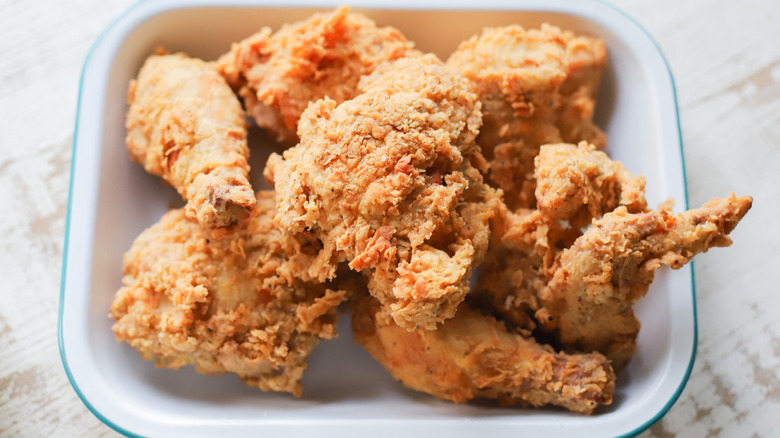
Ingredients
- 1 whole chicken (5-6 pounds)
- 6 cups buttermilk, divided
- 1/2 cup plus 1 tablespoon kosher salt, divided
- 1/4 cup white sugar
- 3 cloves garlic, sliced
- 3 tablespoons celery seed, divided
- 1 tablespoon paprika
- 3 teaspoons cayenne pepper, divided
- 3 cups all-purpose flour
- 1 tablespoon freshly ground pepper
- Peanut oil (for frying)
Directions
- Cut chicken into eight pieces (two each of breasts, thighs, drumsticks, and wings). Set aside.
- In large bowl, whisk together 4 cups buttermilk, 1/2 cup salt, sugar, garlic, 2 tablespoons celery seed, paprika, and 2 teaspoons cayenne pepper. Add chicken and turn to make sure each piece is coated. Cover and refrigerate at least 1 hour and up to 4.
- After chicken has marinated, rinse pieces and pat dry lightly. Discard buttermilk marinade.
- In a large bowl, whisk together flour, remaining tablespoon salt, remaining tablespoon celery seed, remaining teaspoon cayenne, and ground pepper. Place remaining 2 cups buttermilk in a separate bowl.
- Heat oil (about 2 quarts) in a large Dutch oven to 325 F. Working one piece at a time, add chicken to flour and shake to coat. Remove and dip in buttermilk, then back in the flour. Shake off excess and carefully place in oil.
- Fry until golden brown and chicken is cooked through; this will take 5 to 10 minutes, depending on size of the piece. Repeat with remaining chicken.
